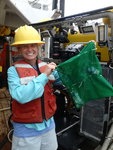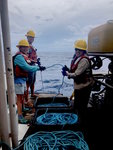DAPHNE – When scientists on a research vessel in the Gulf of Mexico discovered the only giant squid ever seen in the Western Hemisphere, and only the second on Earth, Dr. Megan McCall was one of …
This item is available in full to subscribers.
Please log in to continue |


DAPHNE – When scientists on a research vessel in the Gulf of Mexico discovered the only giant squid ever seen in the Western Hemisphere, and only the second on Earth, Dr. Megan McCall was one of the first to realize something amazing was happening.
McCall, Science, Technology, Engineering, Art and Math, or STEAM, coordinator at Bayside Academy, was one of the expedition members in June. The research vessel Point Sur was about 100 miles southeast of New Orleans on June 19 when technicians noticed something on a video from a remotely operated vehicle, a robot submarine.
“I was sitting in the lab, just off to the side when they called Dr. Nathan Robinson,” she said. “I could see him go get Dr. (Edie) Widder. I didn’t even have to see his face, I could feel the energy and realized something amazing was going on.”
On one set of videos, the technicians caught a glimpse of a tentacle. They kept watching. On the third set, the giant squid swam into view. A live giant squid had only been seen once anywhere on the planet. That was off Japan in 2012. Now one had been recorded in the Gulf south of Mobile Bay.
“We watched it over and over. It was thrilling. I thought to myself that this is epic,” she said. “This is absolutely epic. It was so amazing that it was just there.”
The video was taken at a depth of 759 meters, almost a half mile down. The recording was done by the Medusa, an ROV operated from the ship. The Medusa was lowered from the ship with a bait device designed to attract marine life at extreme depths.
The Medusa was designed by Dr. Edie Widder. In her office at Bayside, McCall showed off a much smaller device, about 18 inches square, made of plastic tubing and electronics.
“We made this here,” she said. “Medusa is much more complex, but it shows how this technology that the students study is used in the real world.”
She also pointed out a foam cup about the size of a thimble. That was a standard-sized eight-ounce coffee cup before it was attached to the Medusa and lowered into the depths. The extreme pressure forced the air out of the foam, leaving a shrunken remnant.
Researchers also used two other devices to recover and observed marine life. The Tucker trawl scooped up creatures in the deep and returned them to the ship for study. The Global Explorer ROV could also be sent down to study marine life.
In addition to the squid, the expedition found a wide variety of strange fish, shrimp and other creatures.
“Even before we saw the squid, this was all so exciting,” she said. “This is what I want to show the students, what there is out there that they can learn and discover one day.”
She showed photos of shrimp that were bright red in the light of the labs. In the ocean, however, red light is the first color absorbed by the water, so red can be a camouflage.
Another species of fish was a deep black. It was the darkest black known on an animal. “This fish is, you might say, the blackest black there is, that we know of,” she said.
McCall was one of only 12 researchers on Point Sur that took part in the 15-day trip. One of her main jobs on the expedition was to coordinate postings on the progress of the voyage and research.
She said the trip did not get off to a great start. “Right after we left Gulfport, we got hit by a storm that stayed with us two days,” she said. “It like being in a washing machine for two days.”
Later, a water spout passed close to the ship.
“Even with everything that happened, thought, it was phenomenal,” she said.
The expedition, Journey into Midnight: Light and Life Below the Twilight Zone, was funded by the National Oceanic and Atmospheric Administration’s Office of Ocean Exploration and Research.
Researchers explored the water column in some of the deepest parts of the Gulf of Mexico to study how deep-sea animals function without light.
McCall, who has been STEAM coordinator at Bayside for three years, has taken part in two previous expeditions, one to the Artic and one to the Antarctic.